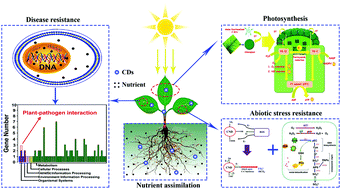A review on the effects of carbon dots in plant systems
Abstract
Carbon dots (CDs), a novel member of the renowned carbon-based nanomaterials family, have gained tremendous attention in various fields. Their extraordinary properties, including facile synthesis procedure, photoluminescence, biocompatibility, tunable surface functionalities, water solubility and low toxicity, have introduced them extensively in biological applications, such as bioimaging, biosensing, photocatalysis and molecule delivery. Recently, CDs have attracted significant interest in agriculture to improve the growth and production of plants and great progress has been achieved in this area. Here, we will review the interactions of CDs with plant systems for the first time, including symptomatic plant growth, internal physiological processes and other external factors involved in plant growth. Furthermore, the current challenges and future perspective of CDs in the field of agriculture are discussed. Looking forward, it indicates that CDs might play an important role in the future of agriculture.

- This article is part of the themed collections: 2020 Materials Chemistry Frontiers Review-type Articles and Carbon Dots


 Please wait while we load your content...
Please wait while we load your content...